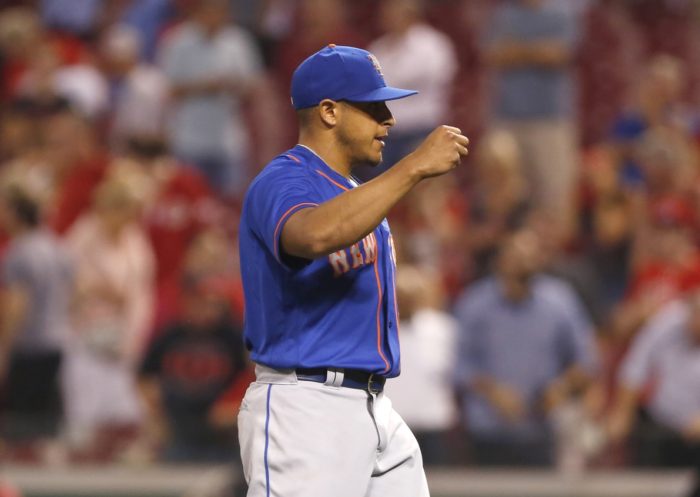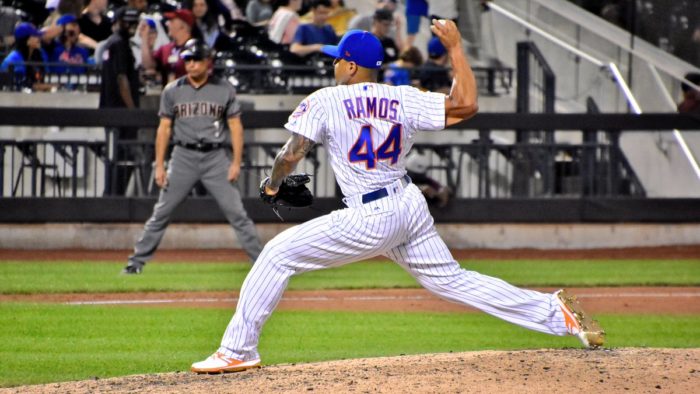
When the New York Mets acquired AJ Ramos from the Miami Marlins last season, we all knew it was a move Sandy Alderson was making while looking ahead to 2018. Well, here we are.
After looking good over his first month in Flushing last season, pitching to a 2.31 ERA in August, Ramos got hit hard in September that left the Mets and their fans a little short-of-confidence in him heading into this season.
Ramos has had his fair share of success in the major leagues. As a rookie for the Marlins in 2013, he made 68 appearances, pitching to a 3.15 ERA. Not too shabby for a first-year player.
His 2014 was even better. His ERA dropped down to 2.11 and his K/9 made a modest increase from 9.7 to 10.3. His WHIP remained virtually unchanged, dropping a few hundredths of a point from 1.26 to 1.23.
In 2015 Ramos took over the closer’s role when incumbent Steve Cishek lost the job. Ramos finihsed arguably his best season with a 2.30 ERA, career-best 1.01 WHIP and another career-best with his 3.35 SO/W.
Although 2016 saw Ramos amass 40 saves and get his first All-Star nod, his numbers took a bit of a hit compared to the previous year. His ERA jumped to 2.81, and his WHIP (1.359) and K/9 (10.3) also worsened. Ramos was never in danger of being labeled as having “lost his stuff”, but there were concerns growing in Miami, no doubt.
Ramos continued to struggle (5.2 BB/9 in 2016) with his control for the Marlins in 2017 with 22 walks in 39.2 innings (5.0 BB/). This led to a 1.31 WHIP, 3.63 ERA and only 2.14 SO/W.
His first month-and-a-half with the Mets weas fairly clean. After giving up two earned runs in his first inning of work on July 30, Ramos only gave up another three earned runs until September 16 in Atlanta (2 ER, 1 IP).
That rough outing, plus another one three days later in Miami (5 H, 3 ER, 0.2 IP), soured the initially sweet taste left in the mouths of the Mets’ front-office and their fanbase after acquiring Ramos.

We, as fans, were under the assumption that the Mets were getting a guy with closer-level stuff and they would be able to insert him behind Jeurys Familia this season in the back-end of the bullpen.
Walks again were the issue with Ramos with 12 of them for the Mets in only 19.2 innings. The other alarming part was giving up 19 hits in those innings for a guy that has a career 6.4 H/9.
Ramos’ struggles (H/9 and BB/9 rose in 2016 and 2017) over the last couple of seasons, as well as the last month of the season last year, has given everyone serious doubts that he can once again be the pitcher he has been in the past.
The 31-year-old has relied heavily upon his off-speed pitches throughout his career. As per BrooksBaseball.net his fastball has decent velocity but is not overpowering (93 mph average in 2017). His sinker comes in at around the same speed, and we’ve seen it work well for him, albeit in small doses.
His slider and change-up (to a lesser extent) are his bread-and-butter pitches. The accuracy with which he throws them and his propensity to induce ground-balls should play well with the agile Amed Rosario slated to be the starting shortstop this year.
Over his career, he’s seen his pinpoint location pay off. His career swinging-strikes on balls in the strike-zone (Z-Swing%) is 63% and outside of the zone (O-Swing%) is 30.6%. Take into consideration his career 39.8% groundball ratio, you can see why Sandy showed such interest in him in the first place.
Trading for a coveted bullpen piece at the trade deadline with no chance of making the playoffs was obviously a long-sighted move. It was also a gamble, considering how Ramos’ numbers have seemed to curtail in recent years.
If Mets’ skipper Mickey Callaway can push all of the right buttons and get AJ Ramos back to where he was just a few short seasons ago, he could be an extremely effective cog in the Mets’ bullpen this season. Let’s hope the Mets get the 2015 version of Ramos and not the one from last season.














